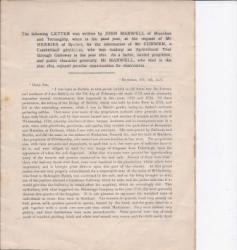
Letter [a printed memoir with no formal title concerning conditions in Scotland in the early eighteenth-century].
Four pages, cr. 8vo, bifolium, not bound, minor blemishes inc. foxing, pencil lines forming large cross on pages 2-3. Full heading: The following LETTER was written by JOHN MAXWELL of Munches and Terraughty, when, in his 92nd year, at the request of Mr HERRIES of Spettes, for he information of Mr CURWEN, a Cumberland gentleman, who was making a Agricultural Tour through Galloway in the year 1811. As a factor, landed proprietor, and public character generally, Mr MAXWELL, who died in the year 1814, enjoyed peculiar opportunities for observation. He recounts events witnessed in his early years such as the falling of the Bridge of Buittle (where he was born), enclosures and introduction of black cattle, large numbers of tenants being turned out (1723), becoming destitute and violent. He describes the clash between proprietors and mob, and the use of Dragoons from Edinburgh. A man on trial was allowed to go free because the judge coveted his horse, illustrating different times. He compares the effects of enclosures on the country to what happened the Mississippi Company in the year 1720 and describes the straightened living conditions of the tenants (diet, clothes, etc.) He goes on to the introduction of potatoes in 1725 from Ireland, but famine conditions prevailing, with difficulties of tramsport. No bridges, no mills, no wheat. He describes conditions prevailing with regard to black cattle, prices etc., commenting on how unscientific farming was but how some started to consider it a science. Yield of estates and their state discussed and evaluated.He adds, In 1739 there were only two carts for hire in the town of Dumfries, and one belonging to a private gentleman. He devotes the last paragraph to the fact that lime wasn't used in buildings or improving the land, giving examples. No copy listed on COPAC and WorldCat, but the text was apparently published in letter, which is included in the New Statistical Account of the parish of Buittle.


